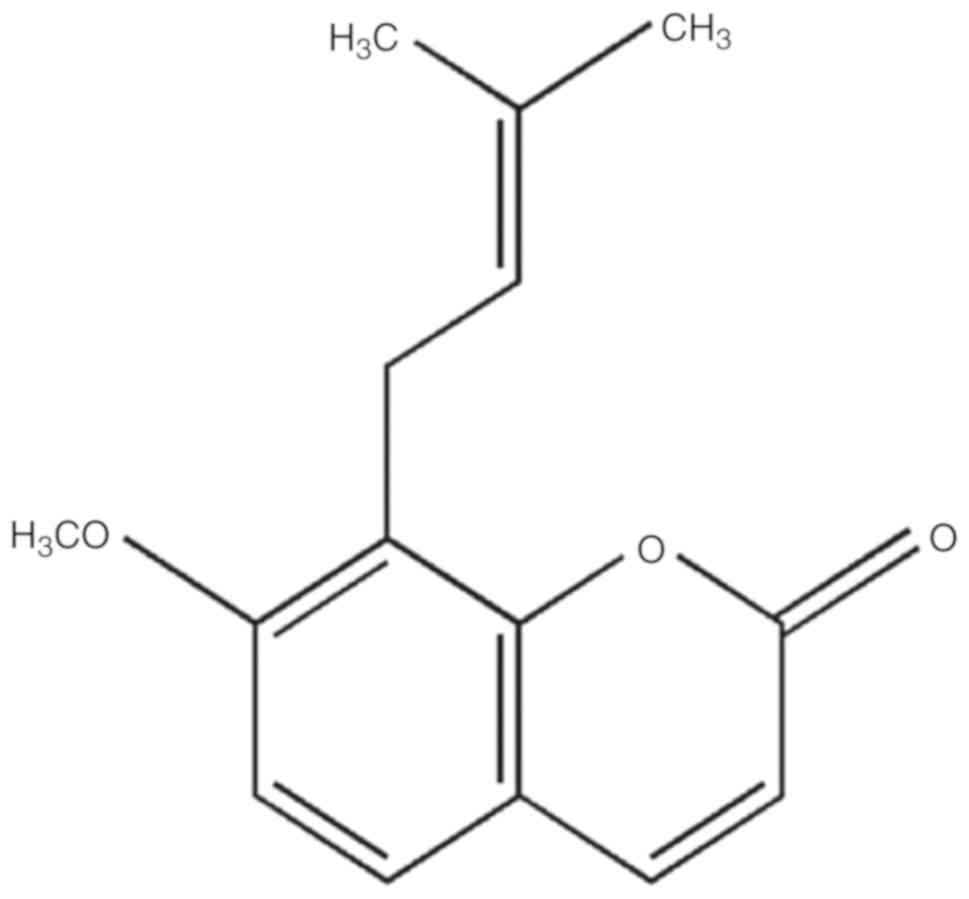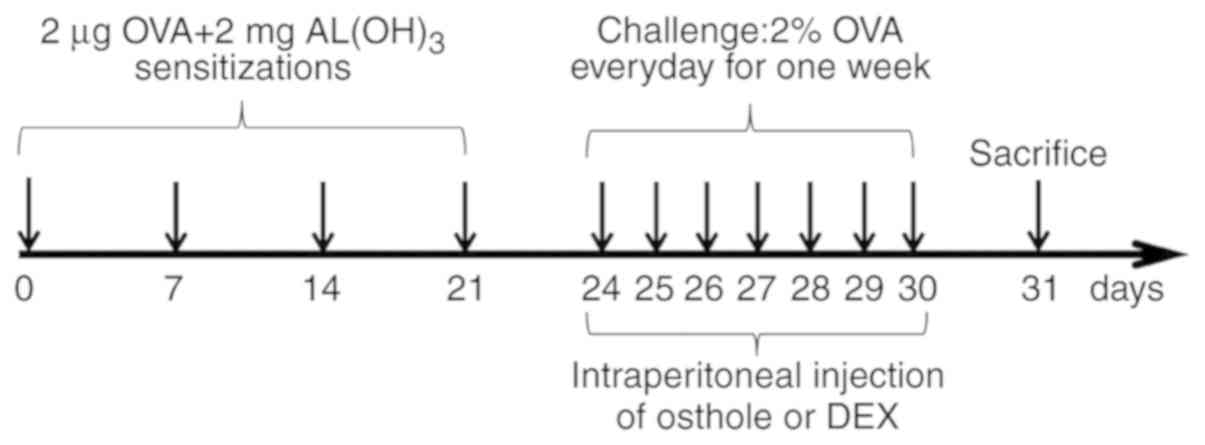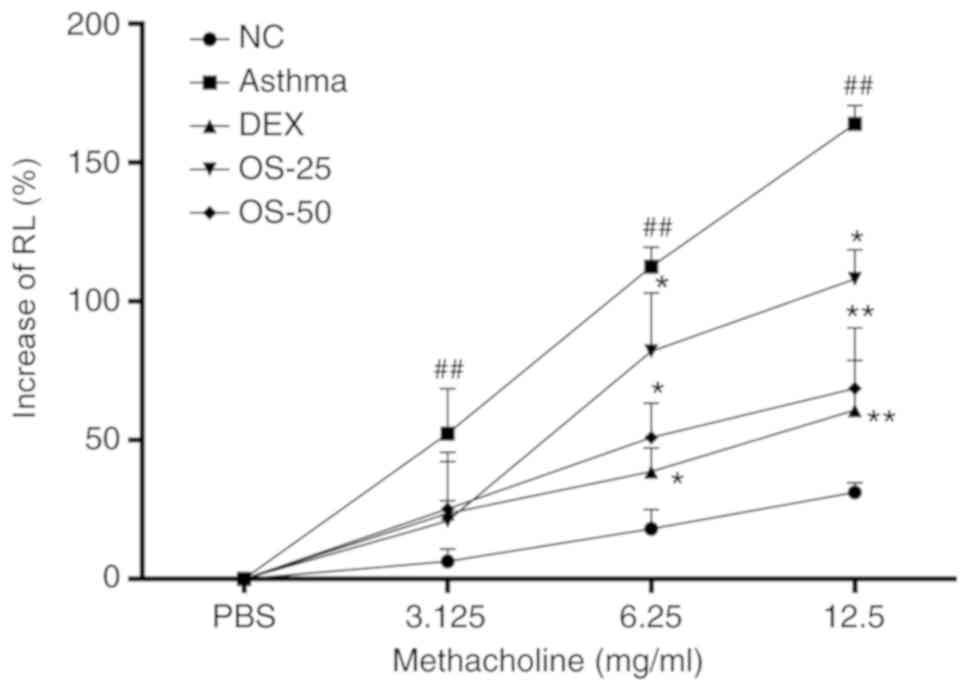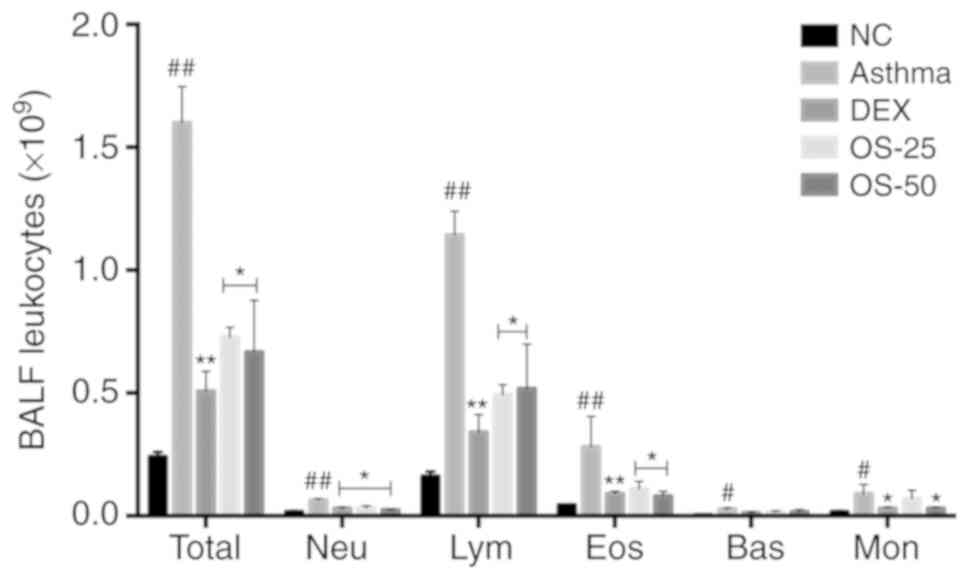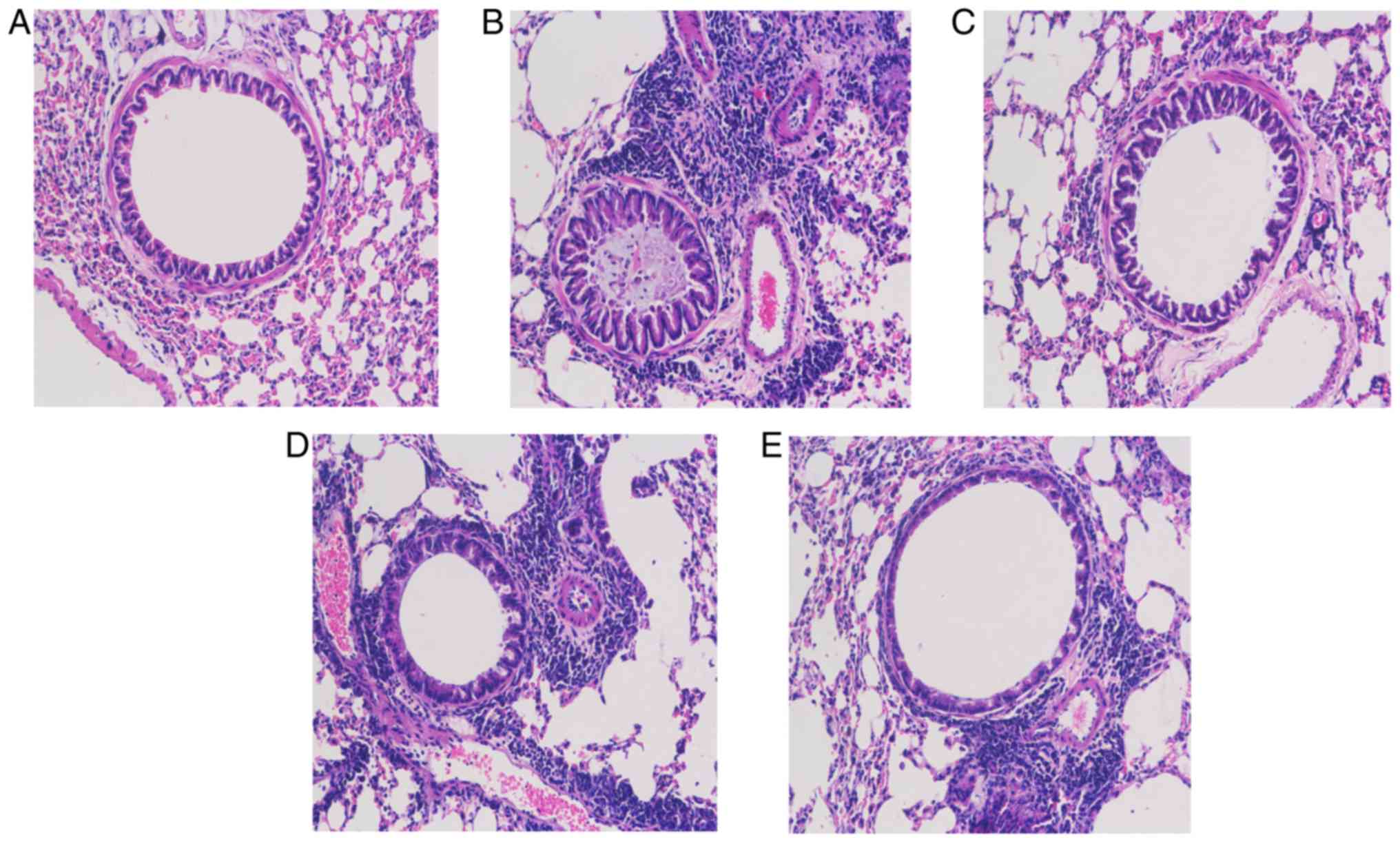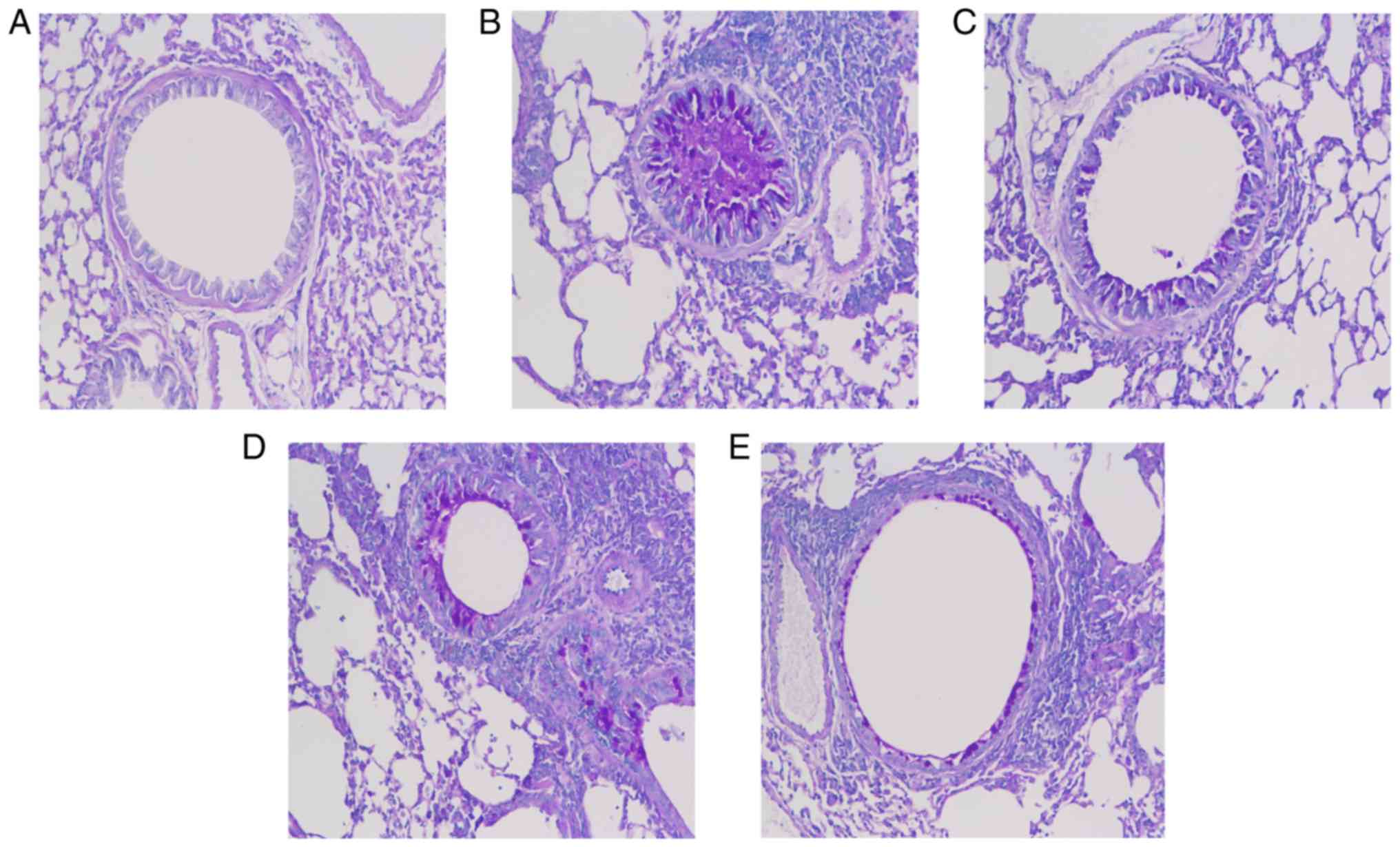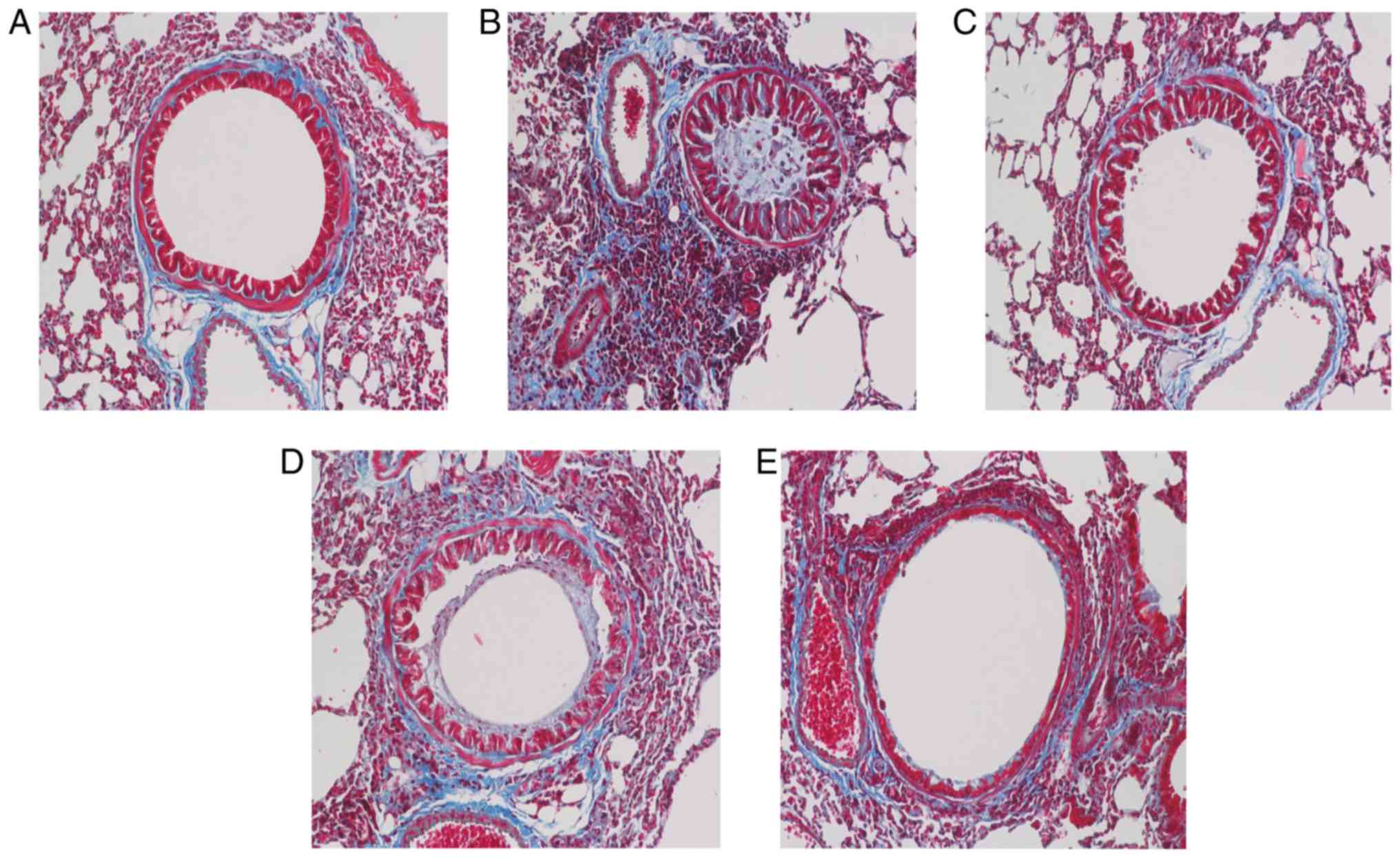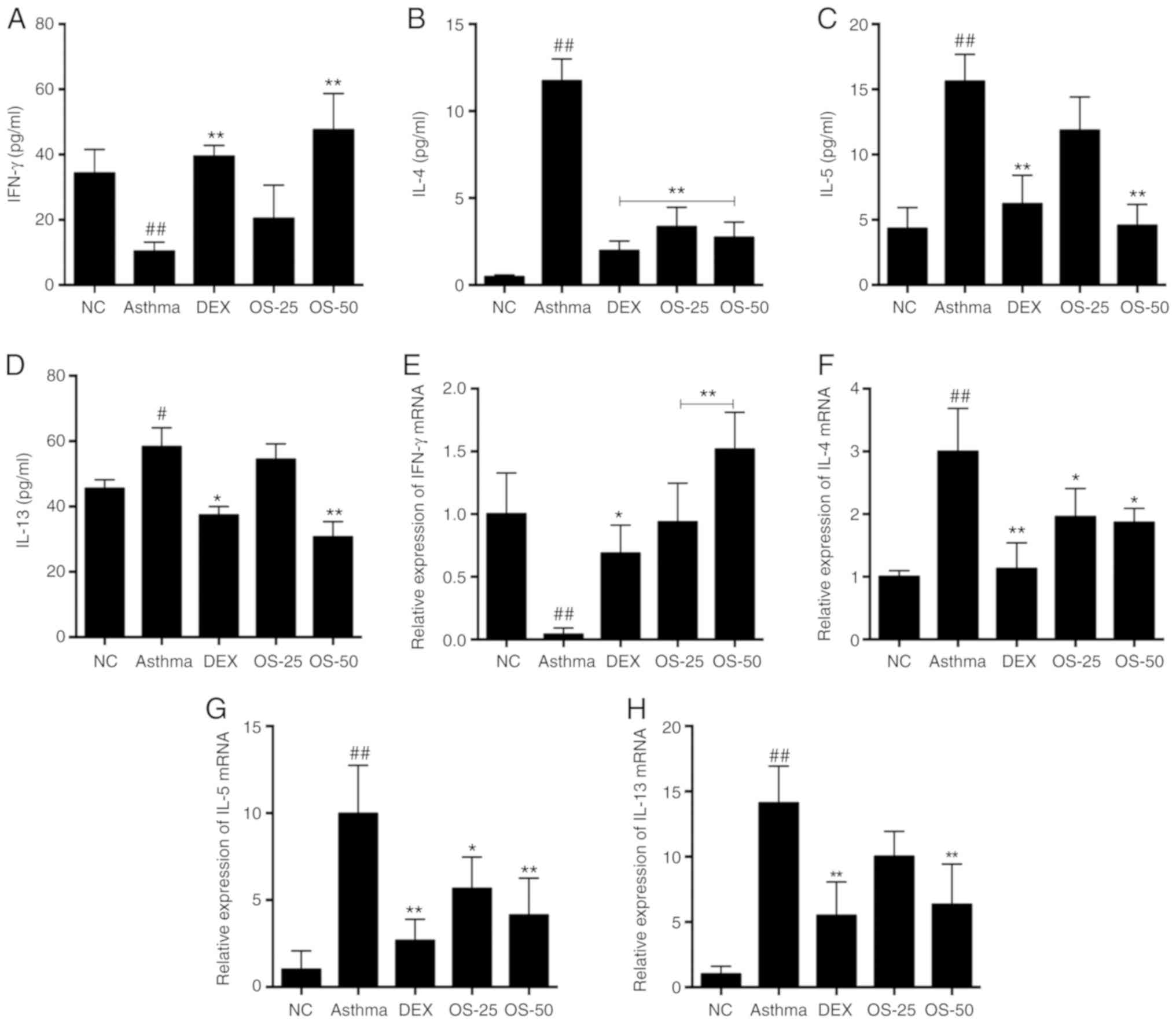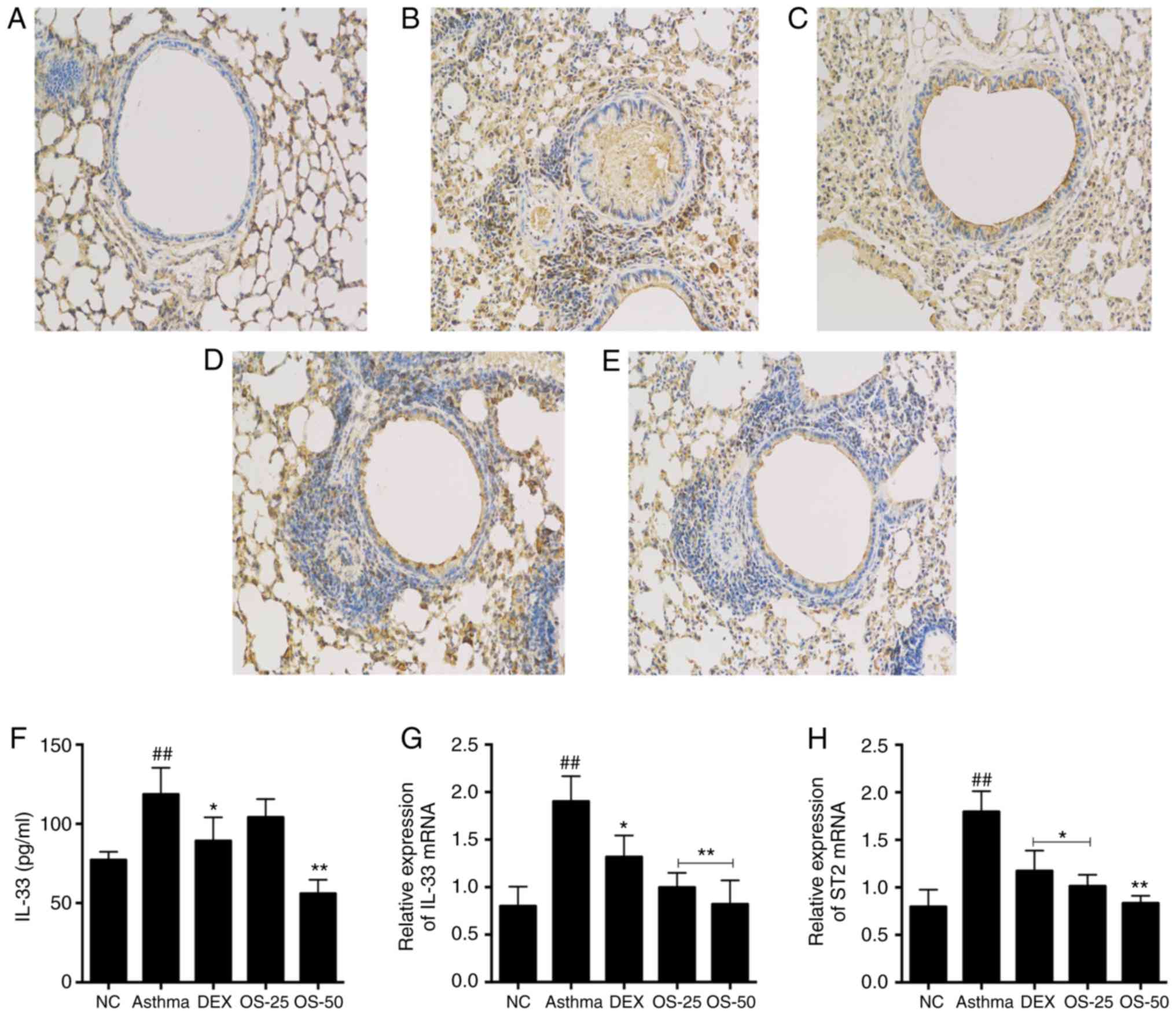|
1
|
Bostantzoglou C, Delimpoura V, Samitas K,
Zervas E, Kanniess F and Gaga M: Clinical asthma phenotypes in the
real world: Opportunities and challenges. Breathe (Sheff).
11:186–193. 2015. View Article : Google Scholar
|
|
2
|
Galli SJ, Tsai M and Pilponsky AM: The
development of allergic inflammation. Nature. 454:445–454. 2008.
View Article : Google Scholar : PubMed/NCBI
|
|
3
|
Bateman ED, Hurd SS, Barnes PJ, Bousquet
J, Drazen JM, FitzGerald M, Gibson P, Ohta K, O'Byrne P, Pedersen
SE, et al: Global strategy for asthma management and prevention:
GINA executive summary. Eur Respir J. 31:143–178. 2008. View Article : Google Scholar : PubMed/NCBI
|
|
4
|
Oliphant CJ, Barlow JL and McKenzie AN:
Insights into the initiation of type 2 immune responses.
Immunology. 134:378–385. 2011. View Article : Google Scholar : PubMed/NCBI
|
|
5
|
Fahy JV: Type 2 inflammation in
asthma-present in most, absent in many. Nat Rev Immunol. 15:57–65.
2015. View
Article : Google Scholar :
|
|
6
|
Martinez FD and Vercelli D: Asthma.
Lancet. 382:1360–1372. 2013. View Article : Google Scholar : PubMed/NCBI
|
|
7
|
Hwang YH, Paik MJ and Yee ST: Diisononyl
phthalate induces asthma via modulation of Th1/Th2 equilibrium.
Toxicol Lett. 272:49–59. 2017. View Article : Google Scholar : PubMed/NCBI
|
|
8
|
Platts-Mills TA: The allergy epidemics:
1870-2010. J Allergy Clin Immunol. 136:3–13. 2015. View Article : Google Scholar : PubMed/NCBI
|
|
9
|
Locksley RM: Asthma and allergic
inflammation. Cell. 140:777–783. 2010. View Article : Google Scholar : PubMed/NCBI
|
|
10
|
Smith DE: IL-33: A tissue derived cytokine
pathway involved in allergic inflammation and asthma. Clin Exp
Allergy. 40:200–208. 2010. View Article : Google Scholar
|
|
11
|
Ravanetti L, Dijkhuis A, Sabogal Pineros
YS, Bal SM, Dierdorp BS, Dekker T, Logiantara A, Adcock IM, Rao NL,
Boon L, et al: An early innate response underlies severe
influenza-induced exacerbations of asthma in a novel
steroid-insensitive and anti-IL-5-responsive mouse model. Allergy.
72:737–753. 2017. View Article : Google Scholar
|
|
12
|
Saluja R, Ketelaar ME, Hawro T, Church MK,
Maurer M and Nawijn MC: The role of the IL-33/IL-1RL1 axis in mast
cell and basophil activation in allergic disorders. Mol Immunol.
63:80–85. 2015. View Article : Google Scholar
|
|
13
|
Kaur D, Gomez E, Doe C, Berair R, Woodman
L, Saunders R, Hollins F, Rose FR, Amrani Y, May R, et al: IL-33
drives airway hyper-responsiveness through IL-13-mediated mast
cell: Airway smooth muscle crosstalk. Allergy. 70:556–567. 2015.
View Article : Google Scholar : PubMed/NCBI
|
|
14
|
Ahmed A and Koma MK: Interleukin-33
triggers B1 cell expansion and its release of monocyte/macrophage
chemoattractants and growth factors. Scand J Immunol. 82:118–124.
2015. View Article : Google Scholar : PubMed/NCBI
|
|
15
|
Iijima K, Kobayashi T, Hara K, Kephart GM,
Ziegler SF, McKenzie AN and Kita H: IL-33 and thymic stromal
lymphopoietin mediate immune pathology in response to chronic
airborne allergen exposure. J Immunol. 193:1549–1559. 2014.
View Article : Google Scholar : PubMed/NCBI
|
|
16
|
Gordon ED, Simpson LJ, Rios CL, Ringel L,
Lachowicz-Scroggins ME, Peters MC, Wesolowska-Andersen A, Gonzalez
JR, MacLeod HJ, Christian LS, et al Alternative splicing of
interleukin-33 and type 2 inflammation in asthma. Proc Natl Acad
Sci USA. 113:8765–8770. 2016. View Article : Google Scholar : PubMed/NCBI
|
|
17
|
Hristova M, Habibovic A, Veith C,
Janssen-Heininger YMW, Dixon AE, Geiszt M and van der Vliet A:
Airway epithelial dual oxidase 1 mediates allergen-induced IL-33
secretion and activation of type 2 immune responses. J Allergy Clin
Immunol. 137:1545–1556. 2016. View Article : Google Scholar
|
|
18
|
Préfontaine D, Nadigel J, Chouiali F,
Audusseau S, Semlali A, Chakir J, Martin JG and Hamid Q: Increased
IL-33 expression by epithelial cells in bronchial asthma. J Allergy
Clin Immunol. 125:752–754. 2010. View Article : Google Scholar : PubMed/NCBI
|
|
19
|
Guo Z, Wu J, Zhao J, Liu F, Chen Y, Bi L,
Liu S and Dong L: IL-33 promotes airway remodeling and is a marker
of asthma disease severity. J Asthma. 51:863–869. 2014. View Article : Google Scholar : PubMed/NCBI
|
|
20
|
Savenije OE, Mahachie John JM, Granell R,
Kerkhof M, Dijk FN, de Jongste JC, Smit HA, Brunekreef B, Postma
DS, Van Steen K, et al: Association of IL33-IL-1 receptor-like 1
(IL1RL1) pathway polymorphisms with wheezing phenotypes and asthma
in childhood. J Allergy Clin Immunol. 134:170–177. 2014. View Article : Google Scholar : PubMed/NCBI
|
|
21
|
Keenan CR, Salem S, Fietz ER, Gualano RC
and Stewart AG: Glucocorticoid-resistant asthma and novel
anti-inflammatory drugs. Drug Discov Today. 17:1031–1038. 2012.
View Article : Google Scholar : PubMed/NCBI
|
|
22
|
He XF, Pan WD, Yao YL and Zhang HM: Recent
highlights of Chinese herbs in treatment of allergic disease:
Acting via mitogen-activated protein kinase signal pathway. Chin J
Integr Med. 23:570–573. 2017. View Article : Google Scholar
|
|
23
|
Shao YY, Zhou YM, Hu M, Li JZ, Chen CJ,
Wang YJ, Shi XY, Wang WJ and Zhang TT: The anti-allergic rhinitis
effect of traditional Chinese medicine of shenqi by regulating mast
cell degranulation and Th1/Th2 cytokine balance. Molecules.
22:E5042017. View Article : Google Scholar : PubMed/NCBI
|
|
24
|
Li YQ, Wang JY, Qian ZQ, Li YL, Li WN, Gao
Y and Yang DL: Osthole inhibits intimal hyperplasia by regulating
the NF-κB and TGF-β1/Smad2 signalling pathways in the rat carotid
artery after balloon injury. Eur J Pharmacol. 811:232–239. 2017.
View Article : Google Scholar : PubMed/NCBI
|
|
25
|
Gao Z, Wen Q, Xia Y, Yang J, Gao P, Zhang
N, Li H and Zou S: Osthole augments therapeutic efficiency of
neural stem cells-based therapy in experimental autoimmune
encephalomyelitis. J Pharmacol Sci. 124:54–65. 2014. View Article : Google Scholar : PubMed/NCBI
|
|
26
|
Kordulewska NK, Kostyra E, Cieślińska A,
Fiedorowicz E and Jarmołowska B: Cytokine production by PBMC and
serum from allergic and non-allergic subjects following in vitro
histamine stimulation to test fexofenadine and osthole
anti-allergic proper-ties. Eur J Pharmacol. 791:763–772. 2016.
View Article : Google Scholar : PubMed/NCBI
|
|
27
|
Chen X, Pi R, Zou Y, Liu M, Ma X, Jiang Y,
Mao X and Hu X: Attenuation of experimental autoimmune
encephalomyelitis in C57 BL/6 mice by osthole, a natural coumarin.
Eur J Pharmacol. 629:40–46. 2010. View Article : Google Scholar
|
|
28
|
Hua KF, Yang SM, Kao TY, Chang JM, Chen
HL, Tsai YJ, Chen A, Yang SS, Chao LK and Ka SM: Osthole mitigates
progressive IgA nephropathy by inhibiting reactive oxygen species
generation and NF-κB/NLRP3 pathway. PLoS One. 8:e777942013.
View Article : Google Scholar
|
|
29
|
Matsuda H, Tomohiro N, Ido Y and Kubo M:
Anti-allergic effects of cnidii monnieri fructus (dried fruits of
Cnidium monnieri) and its major component, osthol. Biol Pharm Bull.
25:809–812. 2002. View Article : Google Scholar : PubMed/NCBI
|
|
30
|
Chiu PR, Lee WT, Chu YT, Lee MS, Jong YJ
and Hung CH: Effect of the Chinese herb extract osthol on IL-4
induced eotaxin expression in BEAS-2B cells. Pediatr Neonatol.
49:135–140. 2008. View Article : Google Scholar : PubMed/NCBI
|
|
31
|
Sun J, Wu J, Xu C, Luo Q, Li B and Dong J:
Paeoniflorin attenuates allergic inflammation in asthmatic mice.
Int Immunopharmacol. 24:88–94. 2015. View Article : Google Scholar
|
|
32
|
Glaab T, Daser A, Braun A,
Neuhaus-Steinmetz U, Fabel H, Alarie Y and Renz H: Tidal
midexpiratory flow as a measure of airway hyperresponsiveness in
allergic mice. Am J Physiol Lung Cell Mol Physiol. 280:L565–L573.
2001. View Article : Google Scholar : PubMed/NCBI
|
|
33
|
Milstrey A, Wieskoetter B, Hinze D,
Grueneweller N, Stange R, Pap T, Raschke M and Garcia P:
Dose-dependent effect of parathyroid hormone on fracture healing
and bone formation in mice. J Surg Res. 220:327–335. 2017.
View Article : Google Scholar : PubMed/NCBI
|
|
34
|
Qiao Y, Song L, Zhu C, Wang Q, Guo T, Yan
Y and LI Q: Dataset on preparation of the phosphorylated
counterparts of a momordica charantia protein for studying
antifungal activities against susceptible dose-dependent C.
albicans to antimycotics. Data Brief. 15:370–375. 2017. View Article : Google Scholar : PubMed/NCBI
|
|
35
|
Arancio AL, Cole KD, Dominguez AR,
Cohenour ER, Kadie J, Maloney WC, Cilliers C, Schuh SM, Bisphenol A
and Bisphenol AF: Di-N-Butyl phthalate, and 17β-estradiol have
shared and unique dose-dependent effects on early embryo cleavage
divisions and development in Xenopus laevis. Reprod Toxicol.
84:65–74. 2019. View Article : Google Scholar
|
|
36
|
Schmittgen TD and Livak KJ: Analyzing
real-time PCR data by the comparative C(T) method. Nat Protoc.
3:1101–1108. 2008. View Article : Google Scholar : PubMed/NCBI
|
|
37
|
Virchow JC, Backer V, Kuna P, Prieto L,
Nolte H, Villesen HH, Ljørring C, Riis B and de Blay F: Efficacy of
a house dust mite sublingual allergen immunotherapy tablet in
adults with allergic asthma: A randomized clinical trial. JAMA.
315:1715–1725. 2016. View Article : Google Scholar : PubMed/NCBI
|
|
38
|
Qian J, Ma X, Xun Y and Pan L: Protective
effect of forsythiaside A on OVA-induced asthma in mice. Eur J
Pharmacol. 812:250–255. 2017. View Article : Google Scholar : PubMed/NCBI
|
|
39
|
Wijerathne CUB, Seo CS, Song JW, Park HS,
Moon OS, Won YS, Kwon HJ and Son HY: Isoimperatorin attenuates
airway inflammation and mucus hypersecretion in an
ovalbumin-induced murine model of asthma. Int Immunopharmacol.
49:67–76. 2017. View Article : Google Scholar : PubMed/NCBI
|
|
40
|
Grotenboer NS, Ketelaar ME, Koppelman GH
and Nawijn MC: Decoding asthma: Translating genetic variation in
IL33 and IL1RL1 into disease pathophysiology. J Allergy Clin
Immunol. 131:856–865. 2013. View Article : Google Scholar : PubMed/NCBI
|
|
41
|
Pichery M, Mirey E, Mercier P, Lefrancais
E, Dujardin A, Ortega N and Girard JP: Endogenous IL-33 is highly
expressed in mouse epithelial barrier tissues, lymphoid organs,
brain, embryos, and inflamed tissues: In situ analysis using a
novel Il-33-LacZ gene trap reporter strain. J Immunol.
188:3488–3495. 2012. View Article : Google Scholar : PubMed/NCBI
|
|
42
|
Schmitz J, Owyang A, Oldham E, Song Y,
Murphy E, McClanahan TK, Zurawski G, Moshrefi M, Qin J, Li X, et
al: IL-33, an interleukin-1-like cytokine that signals via the IL-1
receptor-related protein ST2 and induces T helper type
2-associ-ated cytokines. Immunity. 23:479–490. 2005. View Article : Google Scholar : PubMed/NCBI
|
|
43
|
Liew FY, Pitman NI and McInnes IB:
Disease-associated functions of IL-33: The new kid in the IL-1
family. Nat Rev Immunol. 10:103–110. 2010. View Article : Google Scholar : PubMed/NCBI
|
|
44
|
Griesenauer B and Paczesny S: The
ST2/IL-33 axis in immune cells during inflammatory diseases. Front
Immunol. 8:4752017. View Article : Google Scholar : PubMed/NCBI
|
|
45
|
Bønnelykke K, Sleiman P, Nielsen K,
Kreiner-Møller E, Mercader JM, Belgrave D, den Dekker HT, Husby A,
Sevelsted A, Faura-Tellez G, et al: A genome-wide association study
identifies CDHR3 as a susceptibility locus for early childhood
asthma with severe exacerbations. Nat Genet. 46:51–55. 2014.
View Article : Google Scholar
|
|
46
|
Wan Y, Shrine NR, Soler Artigas M, Wain
LV, Blakey JD, Moffatt MF, Bush A, Chung KF, Cookson WO, Strachan
DP, et al: Genome-wide association study to identify genetic
determinants of severe asthma. Thorax. 67:762–768. 2012. View Article : Google Scholar : PubMed/NCBI
|
|
47
|
Morita H, Arae K, Unno H, Miyauchi K,
Toyama S, Nambu A, Oboki K, Ohno T, Motomura K, Matsuda A, et al:
An inter-leukin-33-mast cell-interleukin-2 axis suppresses
papain-induced allergic inflammation by promoting regulatory T cell
numbers. Immunity. 43:175–186. 2015. View Article : Google Scholar : PubMed/NCBI
|
|
48
|
Martin NT and Martin MU: Interleukin 33 is
a guardian of barriers and a local alarmin. Nat Immunol.
17:122–131. 2016. View Article : Google Scholar : PubMed/NCBI
|
|
49
|
Chackerian AA, Oldham ER, Murphy EE,
Schmitz J, Pflanz S and Kastelein RA: IL-1 receptor accessory
protein and ST2 comprise the IL-33 receptor complex. J Immunol.
179:2551–2555. 2007. View Article : Google Scholar : PubMed/NCBI
|
|
50
|
Liew FY, Girard JP and Turnquist HR:
Interleukin-33 in health and disease. Nat Rev Immunol. 16:676–689.
2016. View Article : Google Scholar : PubMed/NCBI
|
|
51
|
Drake LY and Kita H: IL-33: Biological
properties, functions, and roles in airway disease. Immunol Rev.
278:173–184. 2017. View Article : Google Scholar : PubMed/NCBI
|
|
52
|
Jackson DJ, Makrinioti H, Rana BM, Shamji
BWH, Trujillo-Torralbo MB, Footitt J, Del-Rosario J, Telcian AG,
Nikonova A, Zhu J, et al: IL-33-dependent type 2 inflammation
during rhinovirus-induced asthma exacerbations in vivo. Am J Respir
Crit Care Med. 190:1373–1382. 2014. View Article : Google Scholar : PubMed/NCBI
|
|
53
|
Rank MA, Kobayashi T, Kozaki H, Bartemes
KR, Squillace DL and Kita H: IL-33-activated dendritic cells induce
an atypical TH2-type responses. J Allergy Clin Immunol.
123:1047–1054. 2009. View Article : Google Scholar : PubMed/NCBI
|
|
54
|
Kurowska-Stolarska M, Stolarski B, Kewin
P, Murphy G, Corrigan CJ, Ying S, Pitman N, Mirchandani A, Rana B,
van Rooijen N, et al: IL-33 amplifies the polarization of
alternatively activated macrophages that contribute to airway
inflammation. J Immunol. 183:6469–6477. 2009. View Article : Google Scholar : PubMed/NCBI
|
|
55
|
Millien VO, Lu W, Shaw J, Yuan X, Mak G,
Roberts L, Song LZ, Knight JM, Creighton CJ, Luong A, et al:
Cleavage of brinogen by proteinases elicits allergic responses
through Toll-like receptor 4. Science. 341:792–796. 2013.
View Article : Google Scholar : PubMed/NCBI
|
|
56
|
Yanagawa Y, Suzuki M, Matsumoto M and
Togashi H: Prostaglandin E(2) enhances IL-33 production by
dendritic cells. Immunol Lett. 141:55–60. 2011. View Article : Google Scholar : PubMed/NCBI
|















